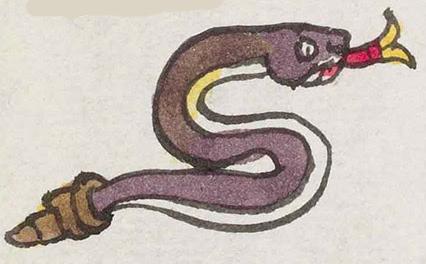coatl (Mdz17v)
This simplex glyph for snake or serpent (coatl) also doubles as the place name, Coatlayauhcan. The snake is poised in the shape of an "S," with a purple back and a white belly. It has rattles on its tail, and it has a bifurcated tongue, red nearer the mouth and yellow at the tips. it is shown in profile, facing to the viewer's right. Two fangs are visible protruding from the mouth, white on the tips and red at the roots. The rattles have a yellow cover over the purple paint.
Stephanie Wood
The glyph for the place name could be considered a compound, because it speaks to not only the coatl but adds the action of tlayahua, to make certain gestures while dancing, according to Alexis Wimmer in the Gran Diccionario del Nahuatl. But the other S-shaped serpent in this collection, the Tziccoatl (see below), is not associated with that verb.
The appearance of the serpent's tongue recalls the glyph for (tletl) (fire or flame) (see below, right). Perhaps the snake's bite caused awe, much as fire did. Serpents did have an association with fire and the fire divinity, Xiuhtecuhtli, as explained by Esther Pasztory (paraphrased by Ian Mursell). The presence of rattles is also important, even if artists often omitted them, because rattlesnakes ware significant in Mesoamerican cultures, as the study of rattlesnakes by Ian Mursell of Mexicolore also elaborates. A wooden, turquoise-mosaic pectoral in the shape of a snake is held in the British Museum, whose curators have written: "The Mexica considered serpents to be powerful, multifaceted creatures that could bridge the spheres (the underworld, water and sky) owing to their physical and mythical characteristics." Besides being an animal that was common in the central highlands, the coatl is the name of the first day of a thirteen-day calendrical cycle.
Stephanie Wood
c. 1541, but by 1553 at the latest
Stephanie Wood
culebras, víboras, serpientes, cohuatl, undulante, colmillas, crótalos

serpent or snake
Stephanie Wood
Codex Mendoza, folio 17 verso, https://digital.bodleian.ox.ac.uk/objects/2fea788e-2aa2-4f08-b6d9-648c00..., image 45 of 188.
The Bodleian Libraries, University of Oxford, hold the original manuscript, the MS. Arch. Selden. A. 1. This image is published here under the UK Creative Commons, “Attribution-NonCommercial-ShareAlike 3.0 License” (CC-BY-NC-SA 3.0).


